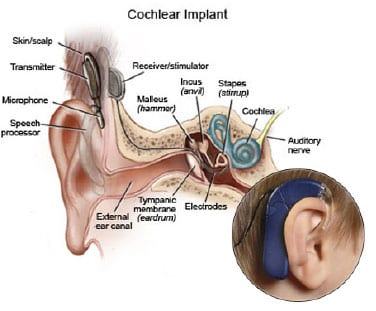Diagnosis
Severely to profoundly deaf adults and children who get little or no benefit from hearing aids. Disorders and conditions include: sensorineural hearing loss, auditory neuropathy, familial hearing loss, genetic hearing loss, meningitis, noise induced hearing loss, otosclerosis, inner ear malformations, enlarged vestibular aqueduct syndrome, Meniere’s disease, acoustic neuroma, neurofibromatosis type 2, superficial siderosis.
Medical device treatment
A cochlear implant is a small, complex electronic device that can help to provide a sense of sound to a person who cannot hear.
How it works

A cochlear implant is very different from a hearing aid. Hearing aids amplify sounds so they may be detected by damaged ears. Cochlear implants bypass damaged portions of the ear and directly stimulate the auditory nerve.
The headset microphone picks up a sound, which travels through a thin cable to a speech processor, which is worn on the ear like a hearing aid or in a pocket. The speech processor converts the signal into an electrical code that is sent back up the cable to the transmitter fastened to the head. The code is sent across the skin to a receiver-stimulator implanted in bone directly beneath the transmitter. The stimulator sends the code down a tiny bundle of wires threaded into the cochlea. Nerve fibers are activated by electrodes on this bundle of wires. The auditory nerve carries the signal to the brain, where is it interpreted as a form of hearing.
However, the result is not the same as normal hearing. It does allow many people to recognize warning signals, understand other sounds in the environment, and enjoy a conversation in person or by telephone. The technology is continuously improving and it is likely that most users will enjoy nearly normal hearing in the future.